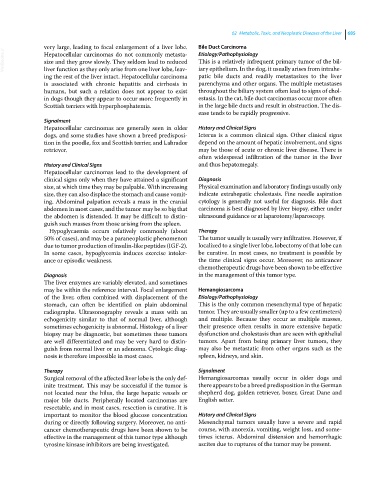Page 717 - Clinical Small Animal Internal Medicine
P. 717
62 Metabolic, Toxic, and Neoplastic Diseases of the Liver 685
very large, leading to focal enlargement of a liver lobe. Bile Duct Carcinoma
VetBooks.ir Hepatocellular carcinomas do not commonly metasta- Etiology/Pathophysiology
This is a relatively infrequent primary tumor of the bil-
size and they grow slowly. They seldom lead to reduced
iary epithelium. In the dog, it usually arises from intrahe-
liver function as they only arise from one liver lobe, leav-
ing the rest of the liver intact. Hepatocellular carcinoma patic bile ducts and readily metastasizes to the liver
is associated with chronic hepatitis and cirrhosis in parenchyma and other organs. The multiple metastases
humans, but such a relation does not appear to exist throughout the biliary system often lead to signs of chol-
in dogs though they appear to occur more frequently in estasis. In the cat, bile duct carcinomas occur more often
Scottish terriers with hyperphosphatemia. in the large bile ducts and result in obstruction. The dis-
ease tends to be rapidly progressive.
Signalment
Hepatocellular carcinomas are generally seen in older History and Clinical Signs
dogs, and some studies have shown a breed predisposi- Icterus is a common clinical sign. Other clinical signs
tion in the poodle, fox and Scottish terrier, and Labrador depend on the amount of hepatic involvement, and signs
retriever. may be those of acute or chronic liver disease. There is
often widespread infiltration of the tumor in the liver
History and Clinical Signs and thus hepatomegaly.
Hepatocellular carcinomas lead to the development of
clinical signs only when they have attained a significant Diagnosis
size, at which time they may be palpable. With increasing Physical examination and laboratory findings usually only
size, they can also displace the stomach and cause vomit- indicate extrahepatic cholestasis. Fine needle aspiration
ing. Abdominal palpation reveals a mass in the cranial cytology is generally not useful for diagnosis. Bile duct
abdomen in most cases, and the tumor may be so big that carcinoma is best diagnosed by liver biopsy, either under
the abdomen is distended. It may be difficult to distin- ultrasound guidance or at laparotomy/laparoscopy.
guish such masses from those arising from the spleen.
Hypoglycaemia occurs relatively commonly (about Therapy
50% of cases), and may be a paraneoplastic phenomenon The tumor usually is usually very infiltrative. However, if
due to tumor production of insulin‐like peptides (IGF‐2). localized to a single liver lobe, lobectomy of that lobe can
In some cases, hypoglycemia induces exercise intoler- be curative. In most cases, no treatment is possible by
ance or episodic weakness. the time clinical signs occur. Moreover, no anticancer
chemotherapeutic drugs have been shown to be effective
Diagnosis in the management of this tumor type.
The liver enzymes are variably elevated, and sometimes
may be within the reference interval. Focal enlargement Hemangiosarcoma
of the liver, often combined with displacement of the Etiology/Pathophysiology
stomach, can often be identified on plain abdominal This is the only common mesenchymal type of hepatic
radiographs. Ultrasonography reveals a mass with an tumor. They are usually smaller (up to a few centimeters)
echogenicity similar to that of normal liver, although and multiple. Because they occur as multiple masses,
sometimes echogenicity is abnormal. Histology of a liver their presence often results in more extensive hepatic
biopsy may be diagnostic, but sometimes these tumors dysfunction and cholestasis than are seen with epithelial
are well differentiated and may be very hard to distin- tumors. Apart from being primary liver tumors, they
guish from normal liver or an adenoma. Cytologic diag- may also be metastatic from other organs such as the
nosis is therefore impossible in most cases. spleen, kidneys, and skin.
Therapy Signalment
Surgical removal of the affected liver lobe is the only def- Hemangiosarcomas usually occur in older dogs and
inite treatment. This may be successful if the tumor is there appears to be a breed predisposition in the German
not located near the hilus, the large hepatic vessels or shepherd dog, golden retriever, boxer, Great Dane and
major bile ducts. Peripherally located carcinomas are English setter.
resectable, and in most cases, resection is curative. It is
important to monitor the blood glucose concentration History and Clinical Signs
during or directly following surgery. Moreover, no anti- Mesenchymal tumors usually have a severe and rapid
cancer chemotherapeutic drugs have been shown to be course, with anorexia, vomiting, weight loss, and some-
effective in the management of this tumor type although times icterus. Abdominal distension and hemorrhagic
tyrosine kinsase inhibitors are being investigated. ascites due to ruptures of the tumor may be present.

